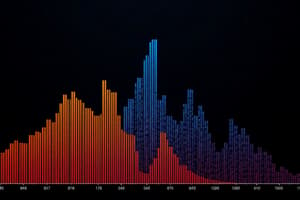Podcast
Questions and Answers
What type of data presentation shows categories and their frequencies?
What type of data presentation shows categories and their frequencies?
- Circle Graph
- Stem and Leaf Plot
- Frequency Table (correct)
- Histogram
Grouped data represents individual observations written out in a list.
Grouped data represents individual observations written out in a list.
False (B)
Define a frequency table.
Define a frequency table.
A frequency table is a two-column table that outlines possible outcomes and associated frequencies observed in a sample.
In a frequency table, the column showing the outcomes is called the ______.
In a frequency table, the column showing the outcomes is called the ______.
How many times did 'green' appear in the frequency table for favorite colors?
How many times did 'green' appear in the frequency table for favorite colors?
Match the following terms with their definitions:
Match the following terms with their definitions:
A histogram uses categorical data while a frequency table uses numerical data.
A histogram uses categorical data while a frequency table uses numerical data.
What is the main purpose of a stem and leaf plot?
What is the main purpose of a stem and leaf plot?
Flashcards are hidden until you start studying
Study Notes
Introduction to Frequency Tables
- A frequency table is a two-column representation showing possible outcomes alongside their respective frequencies in a given sample.
- Example: Favorite colors of 20 students can be organized into a frequency table to display how often each color is chosen.
Frequency Table for Qualitative Data
- A list of colors chosen by students:
- Responses included "purple", "red", "blue", "green", "yellow", and "orange".
- Frequency counts for each color:
- Blue: 4, Green: 6, Orange: 1, Purple: 3, Red: 3, Yellow: 3
Listed Data vs. Grouped Data
- Listed Data: Each observation is recorded as it appears, without any grouping.
- Grouped Data: Data is categorized into equal intervals, creating class intervals on the real number line where each observation can easily fit.
Example of Constructing a Frequency Table
- Numerical variable example provided with data points:
- 2, 2, 6, 3, 5, 4, 4, 7, 5, 2, 7, 4, 5, 3, 2, 2, 5, 7, 2, 4.
- Constructing a frequency table for this data helps summarize and analyze distributions effectively.
Studying That Suits You
Use AI to generate personalized quizzes and flashcards to suit your learning preferences.




